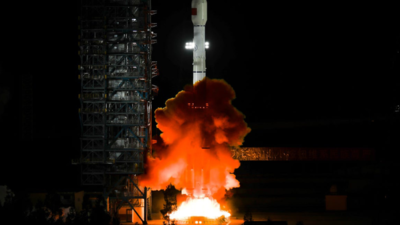Why China is going behind the asteroids with its Tianwen-2 Mission |

China has launched its much-anticipated Tianwen-2 mission, marking a significant milestone in its growing ambitions for deep space exploration. The spacecraft successfully lifted off from the Xichang Satellite Launch Centre on 28 May 2025. Its objective is to collect samples from a near-Earth asteroid and later travel to a distant comet. This mission highlights China’s increasing capability in planetary science and space technology. Scientists hope the mission will shed light on the origins of celestial bodies and the early solar system, while also enhancing China’s standing in the global space community.
Target of Tianwen-2 Mission — A quasi-satellite with lunar hints
The primary target of Tianwen-2 is 469219 Kamo‘oalewa (also known as 2016 HO3), a small and unusual asteroid discovered in 2016 by the Pan-STARRS 1 telescope in Hawaii. It belongs to a rare category called quasi-satellites, which orbit the Sun but stay relatively close to Earth, influenced by its gravity. This unique orbit creates the illusion that Kamo‘oalewa is orbiting Earth. What has intrigued scientists most is that its reflected light spectrum closely resembles that of lunar rocks, suggesting it may be a fragment from the Moon.
Importance of China’s Tianwen-2 Mission
The Tianwen-2 mission places China among a select group of nations, including the United States and Japan, that have succeeded in asteroid sample-return missions. However, China’s objectives go beyond technical achievement.Its mission addresses several scientific and strategic goals:
- Understanding planetary origins: Sampling a quasi-satellite may reveal how such objects formed and evolved.
- Developing new technology: Tianwen-2 will test both “touch-and-go” and “anchor-and-attach” methods to collect asteroid material.
- Improving planetary defence: Studying near-Earth objects could help future efforts to detect and deflect hazardous asteroids.
- Enhancing national prestige: Successful missions demonstrate China’s growing capabilities and leadership in space exploration.
Beyond the asteroid: A double-destination journey
Once Tianwen-2 delivers the asteroid samples to Earth in 2027, it will continue its mission. Using Earth’s gravity for a slingshot manoeuvre, the probe will set course for a second target: comet 311P/PANSTARRS. This object exhibits both asteroid-like and comet-like characteristics, offering a rare opportunity to study the transition between the two.The spacecraft is expected to arrive at 311P around 2035 and will carry out extensive observations using cameras, spectrometers, particle analysers, radar instruments and a magnetometer. The mission may provide clues about the origin of Earth’s water and other vital compounds.
Broader vision behind China’s Tianwen-2 Mission
Tianwen-2 follows China’s successful Tianwen-1 Mars mission and precedes the upcoming Tianwen-3, which aims to return samples from Mars. Later, Tianwen-4 will explore the Jupiter system and possibly Uranus. These missions are part of a long-term vision positioning China as a leading space power by the middle of this century.With Tianwen-2, China is not simply gathering rock samples. It is pursuing deeper knowledge, advancing its scientific capabilities and strengthening its role in international space exploration. The asteroid’s secrets, locked away for billions of years, may help to understand how our planet, its Moon and the solar system itself came to be.





